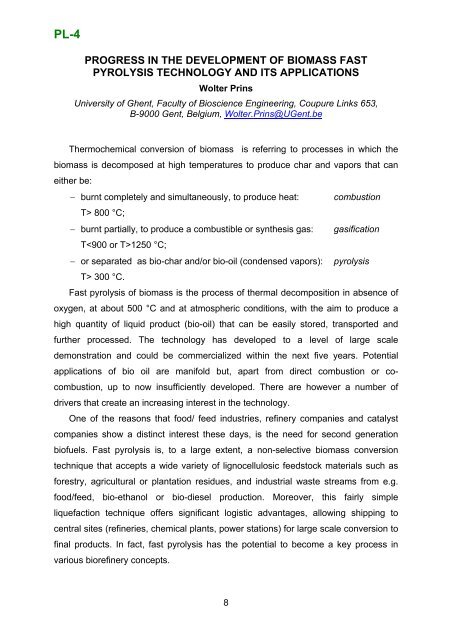Boreskov Institute of Catalysis SB RAS, Novosibirsk, Russia
Boreskov Institute of Catalysis SB RAS, Novosibirsk, Russia
Boreskov Institute of Catalysis SB RAS, Novosibirsk, Russia
- No tags were found...
Create successful ePaper yourself
Turn your PDF publications into a flip-book with our unique Google optimized e-Paper software.
PL-4PROGRESS IN THE DEVELOPMENT OF BIOMASS FASTPYROLYSIS TECHNOLOGY AND ITS APPLICATIONSWolter PrinsUniversity <strong>of</strong> Ghent, Faculty <strong>of</strong> Bioscience Engineering, Coupure Links 653,B-9000 Gent, Belgium, Wolter.Prins@UGent.beThermochemical conversion <strong>of</strong> biomass is referring to processes in which thebiomass is decomposed at high temperatures to produce char and vapors that caneither be:− burnt completely and simultaneously, to produce heat: combustionT> 800 °C;− burnt partially, to produce a combustible or synthesis gas: gasificationT1250 °C;− or separated as bio-char and/or bio-oil (condensed vapors): pyrolysisT> 300 °C.Fast pyrolysis <strong>of</strong> biomass is the process <strong>of</strong> thermal decomposition in absence <strong>of</strong>oxygen, at about 500 °C and at atmospheric conditions, with the aim to produce ahigh quantity <strong>of</strong> liquid product (bio-oil) that can be easily stored, transported andfurther processed. The technology has developed to a level <strong>of</strong> large scaledemonstration and could be commercialized within the next five years. Potentialapplications <strong>of</strong> bio oil are manifold but, apart from direct combustion or cocombustion,up to now insufficiently developed. There are however a number <strong>of</strong>drivers that create an increasing interest in the technology.One <strong>of</strong> the reasons that food/ feed industries, refinery companies and catalystcompanies show a distinct interest these days, is the need for second generationbi<strong>of</strong>uels. Fast pyrolysis is, to a large extent, a non-selective biomass conversiontechnique that accepts a wide variety <strong>of</strong> lignocellulosic feedstock materials such asforestry, agricultural or plantation residues, and industrial waste streams from e.g.food/feed, bio-ethanol or bio-diesel production. Moreover, this fairly simpleliquefaction technique <strong>of</strong>fers significant logistic advantages, allowing shipping tocentral sites (refineries, chemical plants, power stations) for large scale conversion t<strong>of</strong>inal products. In fact, fast pyrolysis has the potential to become a key process invarious biorefinery concepts.8
















